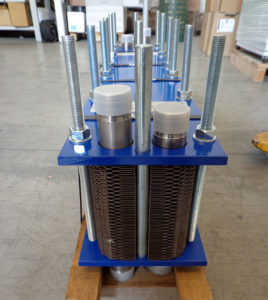Heat exchangers
An heat exchanger is an equipment aimed to transfer thermal energy (heat) between two fluids having different temperatures. There are several kind of heat exchangers, depending on the kind of fluid involved in the thermal transfer process. Heat exchangers are ‘passive equipments’, meaning that they don’t actively generate heat, they simply transfer it.
There are two main types of exchangers, direct contact exchangers and surface exchangers. We are going to talk about the second type, which can be classified following their construction typology.
- Shell and tube heat exchangers: the primary fluid flows through the tubes, that usually have a circular section, and the secondary flows over the external surface of the tubes and within a shell, equipped with dedicated deflectors aimed to increase its turbulence (the swirling and agitated movement of the fluid increases the thermal transfer rate)
- Plate heat exchangers: the two fluids flow on the opposite surfaces of a corrugated or smooth metal sheet, with the insertion of turbulators in alternate chambers isolated by gaskets or weldings (exchangers that can be inspected or welded exchangers, respectively), tipically in counter-current
- Coil heat exchangers: the two fluids flow on the opposite surfaces of a smooth metal sheet in chambers rolled up in a spiral
- Block type heat exchangers: the fluids flow through circular bores (or ovoid) usually disposed orthogonally on the two sides (typical construction in graphite)
- Finned pack heat exchangers or with radiators pack: the primary fluid flows through tubes, while the secondary (a gas) flows through the finned pack on the outside of the tubes




 Back to index
Back to index Download the complete book
Download the complete book